Solus Wedge Review – 420 CS and 720 CS
Solus is a name that some of you may recognize. As a manufacturer of some very unique wedges, Solus accumulated a number of followers after coming onto the equipment scene. While we haven’t heard as much from them in recent times, Solus now has two new wedge offerings out there that I’ve been reviewing, the 420 CS and 720 CS.
Solus 420 CS Wedge

The 420 CS wedge was designed for players that have just started golfing to intermediate range. The wedge features make it as easy as possible to hit straighter, more predictable shots. The perfect wedge to help get your game to the next level!
Features
- Crescent Cut Sole: Gives the Solus wedge more flexibility in shot selection by lowering the leading edge and giving extra bounce control
- Optimal Center of Gravity: Solus wedges contain a higher, more “rearward” center of gravity allowing for a better distance consistency and stability
- Pro Grind Heel: A camber has been added to the heel area of the crescent cut sole making it much easier to play the hard-to-hit, open face cut shots
- Perimeter Weighting: Full perimeter weighting helps to control distance and direction on off-center shots, making for a more consistent short game
720 CS Wedge
The Solus Tour 720 wedge was specifically designed for the more advanced player. The enhanced features of the 720 CS make it easier to create high spin and give the player added distance control, taking their short game to the next level.
Features
- Crescent Cut Sole: Gives the Solus wedge more flexibility in shot selection by lowering the leading edge and giving extra bounce control
- Optimal Center of Gravity: Solus wedges contain a higher, more “rearward” center of gravity allowing for a better distance consistency and stability
- Pro Grind Heel: A camber has been added to the heel area of the crescent cut sole making it much easier to play the hard-to-hit, open face cut shots
- Computer Milled Grooves: The computer milled grooves creates a “microgroove surface” to the face of the club, making it possible to create a very high spin when necessary
Aesthetics – 420 CS
As their “game improvement” wedge offering, Solus incorporated some perimeter weighting into the 420 CS. This is easy to see when looking at the back of the club, which has material removed from three distinct sections. The wedge features a smoky gray finish that may appeal to those people looking to avoid glare. The most obvious visual feature on the 420 CS (and 720 CS for the matter) is the Crescent Cut Sole, which will be discussed in more detail shortly. The sole looks as if somebody took a scoop of metal right out of it, leaving a small indentation.
Both wedges have a Solus branded shaft and grip, with yellow and black being the predominant colors. Though small in the big picture, my experience was that the grip became very slick in the hot and humid Midwest summer, so those of you that play in similar conditions may consider switching it out.
One very apparent characteristic of both wedges was how light they felt in the head and in general. Compared to the wedges I currently play, there was a noticeable difference in swing weight. While that didn’t appear to affect me in any manner, I do think it bears mentioning for those that are more sensitive to that type of thing. Unfortunately, I couldn’t find a full list of product specifications, so I do not know the exact swing weight. At impact, the 420 CS seemed to be the ‘softer’ of the two wedges, and really stood among the softer wedges I’ve tried in recent times.
Aesthetics – 720 CS Wedge
The 720 CS looks very much like any typical blade wedge, aside from the aforementioned sole design. It’s compact in size and shape and lacks the perimeter weighting of the 420 CS. In contrast to the smoky finish of the 420 CS, this wedge is a satin chrome that I personally enjoyed the most of the two. With a very slight rounding to the leading edge, I was very comfortable addressing the ball in even the barest of lies.
Again, there was an obvious lightness that I noticed with the 720 CS in hand. I would characterize the feel at impact as solid, with a firmer click than the 420 offered.
Crescent Cut Sole and Pro Grind Heel Technology
CCS is the key piece of technology that Solus has to offer, and while not new by any means, it is an interesting concept. The scooped out sole is not just there for looks, but rather creates versatility. Essentially, the CCS lowers the leading edge closer to the ground on square face shots, which should help reduce the potential for thin shots, especially on firm or tight lies, while still providing that needed bounce in situations that require it, i.e. bunker shots.
Pro Grind Heel is a design element that, in theory, makes playing an open-face shot easier. In summary, these two grinds should give the user the ability to successfully play a number of shots on the golf course.
Performance
In addition to the golf course, Solus wedge testing took place at multiple driving ranges and short game areas, with the goal of getting a good sampling of ground conditions. I tested the 420 CS in 60° of loft and the 720 CS at 50°. The most succinct way I can summarize what I found is to say that they performed nicely. I didn’t find a situation that they blatantly struggled with.
Though I rarely take them on the course, I did take full swings with both wedges on the driving range. Unsurprisingly, ball flight from these shots was quite high. There was not excessive digging, though I admittedly am not a big divot-taker. I can’t really say that I saw a noticeable difference in forgiveness between the two wedges on full shots, even though one features perimeter weighting and the other does not. Forgiveness is not always easy for me to gauge in high-lofted clubs, so your observations may vary there.
The most common shots that I take with wedges are partial swings in the 40 to 90 yard range. Unless conditions require something different, I tend to keep a square face for these shots. I found pleasing results from both wedges here, with consistent distance control and the ability to alter trajectory via ball placement and swing length. My last testing session was on baked-out ground that was a mix of hard pan and sparse grass and I found that both wedges worked as anticipated. Since both wedges feature technology designed to enable an easier experience with open faced shots, I also tested them on the same surface, and again found favorable results. This did take a little time to get the proper technique, but once I did that I had no problem hit high, short lobs.
Bunker shots with the 60° 420 CS were easy to execute out of soft sand. I felt like I may have seen a little more digging than normal, but it didn’t cause any issues escaping a high-lipped practice bunker. Firmer sand did present more difficulty until I adjusted my set up a bit more open to get the leading edge into the sand.
Lastly, I didn’t find any issues executing a variety of greenside shots. The 420 CS was especially adept at open-faced touch shots; though that isn’t a shot I attempt all that often.
Regarding spin, I felt like what I saw was adequate taking into consideration technique, conditions, and the ball I was using at any given time. The best description I can give is to say that what I saw was typical of what I’d see from my other wedges, nothing more and nothing less.
Final Thoughts
I haven’t mentioned it to this point, but Solus is what I’d consider a bargain brand at this point in time. Both wedges that I tested can be purchased for around $50 at online retailer www.rockbottomgolf.com. At that price, they certainly present a solid value, both for those looking to save some money building their bags and for fans of the Solus Crescent Cut Sole. For my personal liking, I would have preferred a little more heft and possibly a different shaft, but they performed very well, especially at the price they command.




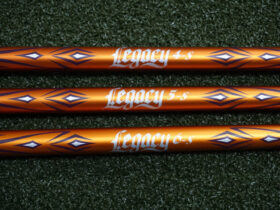



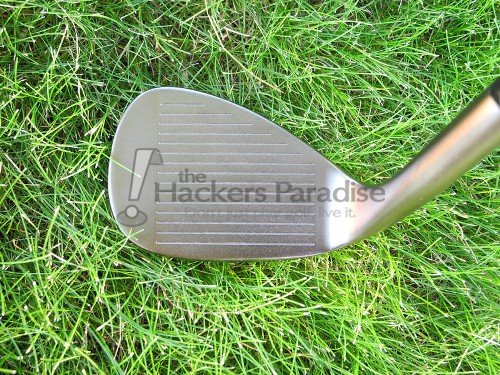
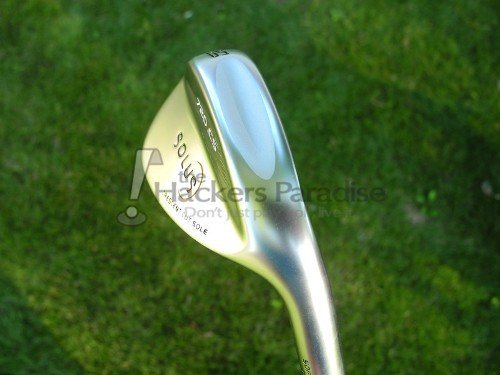
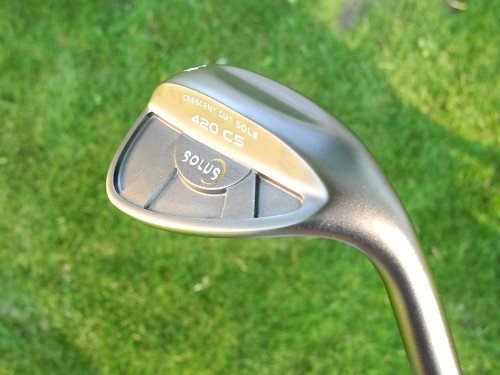
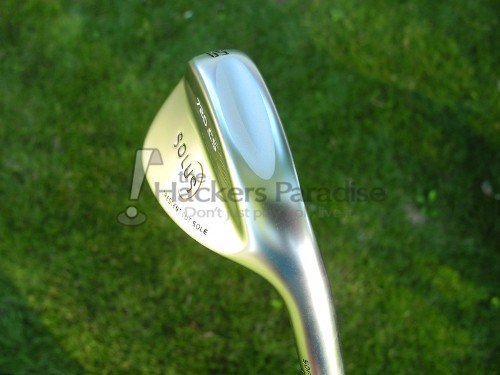
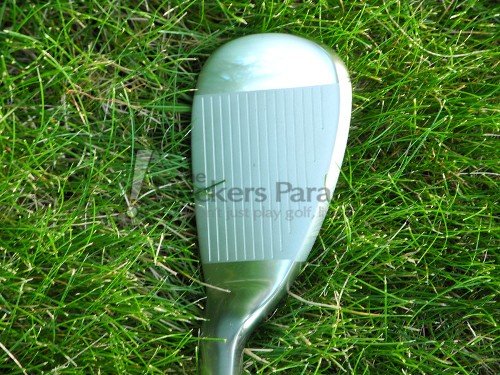
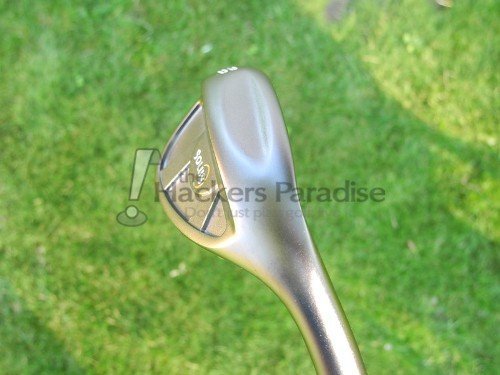





Nice write up Hawk. These are definitely interesting looking wedges. I’m a fan of a little more weight in my wedges, so not sure I’d like the 720. Any clue if these will be available in stores an time?
Very nice Hawk! Sounds like the 420 could be great for a starter at that price point and the 720 could be great for someone looking for the next step. I like the look of the wedges as well.
Another solid review Hawk! This combo reminds me of what Cleveland has done with the CB & MB options.
Perhaps a high lofted MB and a GW lofted CB could be a nice combo. The sole on the 720 definitely jumps out but not in a bad way.
For the price point and someone looking to upgrade on a budget, this seems like a great option.
I purchased a used solus 720 CN 56 degrees from Golfsmith. I am 90 years old, Hcp 17 from green tees in my club in Florida. I play a good game for my age but the sand wedge has always been my problem. I hit the ball over the green and when I try to ease off i hit it out but very short. How can I use this crescent grind club. If they had a 420 I would have purchasewd it if it is easier. Please try to give me some detailed advice. It will be very much appreciated. Thanks, Irv. Kean
Invaluable discussion ! Coincidentally if people are requiring a DoL CC-257 , my colleague edited a blank form here
http://goo.gl/JWK5HD